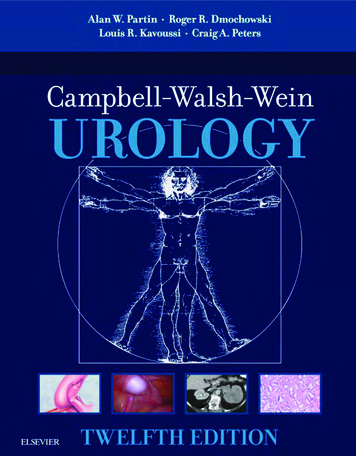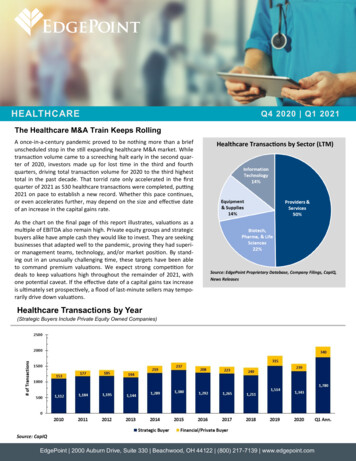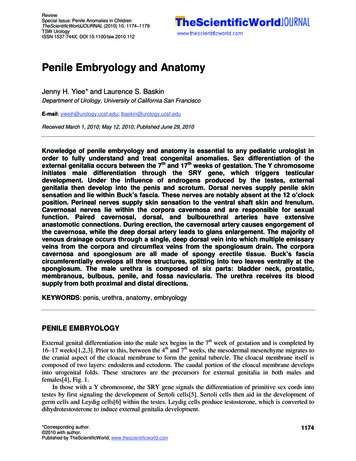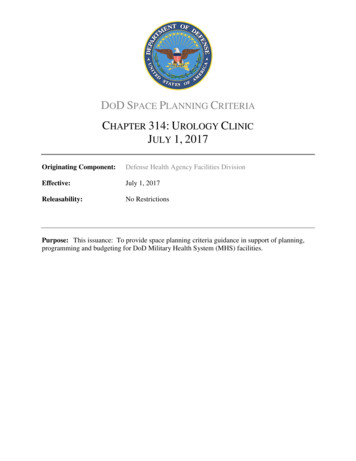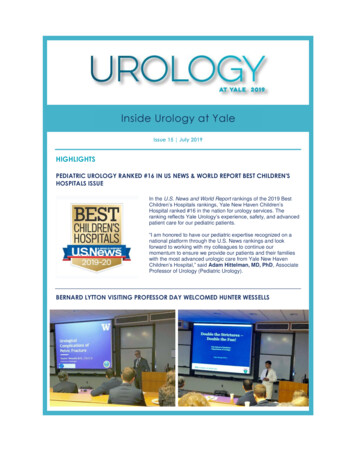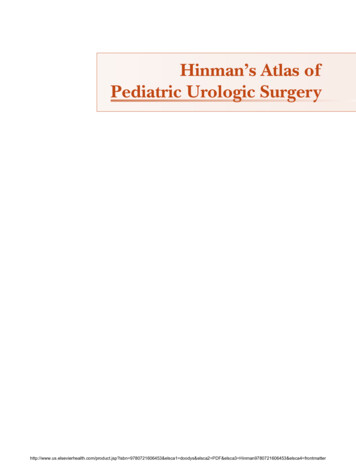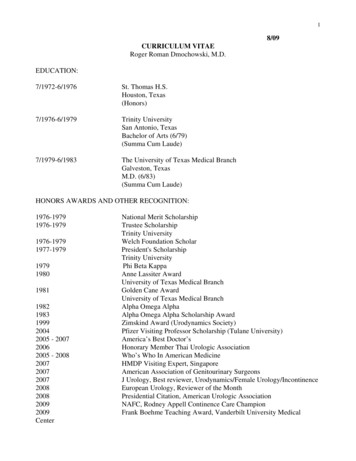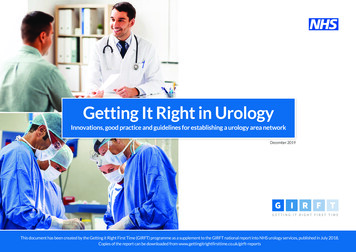
Transcription
Getting It Right in UrologyInnovations, good practice and guidelines for establishing a urology area networkDecember 2019This document has been created by the Getting it Right First Time (GIRFT) programme as a supplement to the GIRFT national report into NHS urology services, published in July 2018.Copies of the report can be downloaded from www.gettingitrightfirsttime.co.uk/girft-reports
ContentsAbout this guide .3Hospital to Home Service: The Dudley Group NHS Foundation Trust.21Recommendations from the GIRFT national report on urology.4Enhanced Recovery Programme for Nephrectomy:University Hospitals of North Midlands NHS Trust .23PART 1: Establishing a urology area network.5Introduction.5Developing a country-wide plan for UANs.6Dealing with core issues.6Network principles.7Network design.7Describing the UAN service using a service specification.8PART 2: Good practice case studies in urology.11Adolescent Urology Services: Newcastle upon Tyne Hospitals NHS Foundation Trust.11Cancer and Benign Separation:Medway NHS Foundation Trust and Dartford and Gravesham NHS Trust .12Establishing a Urological Investigations Unit: Mid-Yorkshire Hospitals NHS Trust.13Nurse-led Botox Injection Service: East Lancashire Hospitals NHS Trust.14Nurse-led Intravesical Botox Injections: Hull University Teaching Hospitals NHS Trust .15Establishing a nurse-led Botox service: Salford Royal NHS Foundation Trust.16Open Access Review Service: Surrey and Sussex Healthcare NHS Trust.17Virtual Review Clinics: Pennine Acute Hospitals NHS Trust.18National Catheter Education Project: Ashford & St Peter’s Hospitals NHS Foundation Trust.19Laser Ablation of Bladder Tumours in an Out-patient Setting :Ashford and St Peter’s Hospitals NHS Foundation Trust.20Patient Days & Co-design Projects: Ashford and St Peter’s Hospitals NHS Foundation Trust .20Patient Telephone Service Following TURP: George Eliot Hospital NHS Trust.212Hospital to Home Service: The Royal Wolverhampton NHS Trust.22Nurse-led Ambulatory Clinic: University Hospitals of North Midlands NHS Trust.24Nurse-led Urology Rapid Access Unit:South Tyneside and Sunderland NHS Foundation Trust .25Remote Follow-up of Patients with Prostate Cancer:Leeds Teaching Hospitals NHS Trust.26Community Follow-up for Patients with Stable Prostate Cancer:Harrogate and District NHS Foundation Trust .27Urological Assessment Unit: Sheffield Teaching Hospitals NHS Foundation Trust.28Consultant Connect Network: South Warwickshire NHS Foundation Trust.29Developing the role of Surgical Care Practitioners:York Teaching Hospitals NHS Foundation Trust.30Utilising Surgical Care Practitioners: University Hospitals of North Midlands NHS Trust.31About GIRFTThe Getting It Right First Time (GIRFT) programme covers 40 surgical andmedical specialties, working directly with frontline clinicians to identify andreduce unwarranted variations in service delivery and clinical practice. EachGIRFT specialty review results in a report that includes a range of evidencebased recommendations that our clinical leads, all experts in their field, feelwould truly make a difference to patient care and efficiency in that specialty. Intackling the variation in the way services are provided and delivered, we are ableto identify recommendations that can help improve the quality of care andoutcomes for patients, as well as helping the NHS deliver much-neededefficiency savings.For details of any of these case studies, email info@gettingitrightfirsttime.co.uk
About this guideThis guide has been written to support hospital trusts in developing their urology servicesand to consider how best to establish a urology area network (UAN). It has beenproduced as a supplement to the GIRFT programme’s national specialty report into NHSurology services, authored by GIRFT clinical lead Simon Harrison and published in July2018. The report was the result of Mr Harrison’s national review of NHS urologyservices in England undertaken between August 2016 and April 2019.During this review Mr Harrison made 134 visits, covering 140 trusts and was able tocapture various evidences of good practice across the country. Following publication ofhis national specialty report in July 2018, Mr Harrison has collated these examples ofgood practice aimed at developing a resource to increase collaboration across trusts toimprove service development and networking.The national GIRFT urology report highlights 18 recommendations. These focus on howresources across this large specialty could be better used to improve the patientexperience by reducing waiting times, enabling more care to be provided via outpatientsettings and providing more effective pathways to definitive treatments.To do that, the report recommends changes to service configuration within trusts,changes to staffing arrangements – extending the role of specialist nurses and askingconsultants to focus more on emergency care – and a greater emphasis on networkingbetween urology departments.Part 1: Setting Up UANsIn this section GIRFT urology clinical lead Simon Harrison highlights what to considerwhen forming networks between trusts. The guide is based on the insight and detailcaptured on his 134 visits, which took place between August 2016 and April 2018.Throughout the document there are suggestions and things to consider whilstestablishing a urology area network. It seeks to help trusts examine how their urologyservices are currently functioning and whether in-house improvements can be made priorto the formation of a UAN.Part 2: Good practice case studiesThis section offers examples of good practice across urology departments which can beused to support the improvement and development of urology services. Each case studysupports one or more GIRFT recommendation and provides information on how it wasestablished and implemented.A key recommendation is No 14: Establish urology area networks (UANs), comprisingseveral urology departments that provide comprehensive coverage of urological services,beyond existing network arrangements, to optimise quality and efficiency.This recommendation encourages trusts to establish networks, with different parts of theurology workload centred at different providers within a urology area network. There arestrong foundations within urology for such a move, in the form of networks for cancercare and reconstructive urology. This document offers guidance and good practiceexamples to help trusts adopt this network approach for a greater range of conditions.3
Recommendations from the GIRFT national report on urologyThe GIRFT National Specialty Report for Urology was published in July 2018 and made 18 recommendations. They are:1. Develop a structured training curriculum for specialist urological nurses and establish accredited training departments.2. Provide job planning for clinical nurse specialists and ensure appropriate skill mix.3. Increase the provision of Urological Investigations Units (UIUs), providing a dedicated resource for urological outpatient care.4. Review follow-up rates against a median of 1:2 first outpatient to follow-up.5. Take further action to improve RTT performance for common conditions and pathways.6. Address the potential adverse effects of existing cancer diagnostic and treatment standards.7. Review guidance for urology cancer MDT working.8. Reduce average length of stay across the specialty through enhanced recovery and increased use of day case pathways, while monitoring causes and rates ofemergency readmissions.9. Improve the secondary care pathway for patients with urinary tract stones.10. Provide consultant-delivered emergency urology care in every trust by reducing elective commitments for consultants on call.11. Review workloads of on-call consultants to ensure the sustainability of on-call arrangements.12. Ensure high-quality emergency urological care is available in all areas seven days a week by focusing available resources at weekends on a smaller number of departments, whileallowing some departments to operate on a five-day basis.13. Review the approach to providing care for patients who require urgent surgery for urinary tract trauma and related conditions.14. Establish urology area networks (UANs), comprising several urology departments that provide comprehensive coverage of urological services, beyond existing networkarrangements, to optimise quality and efficiency.15. Reduce the numbers of complex surgical procedures that are carried out in small volume centres, using networks as they develop.16. Align data collection efforts across urology and ensure that data collected are relevant and have a value that is in proportion to the resources needed for its collection.17. Enable improved procurement of devices and consumables through cost and pricing transparency, aggregation and consolidation, and the spreading of best practice.18. Reduce litigation costs by application of the GIRFT programme’s five-point plan.4
Part 1: Establishing a urology area networkSimon was a consultant urologist at Pinderfields Hospital,Wakefield, from 1992 to December 2016. Pursuing a specialinterest in neurological urology, Simon developed a tertiary referralpractice for patients with complex lower urinary tract dysfunction.Simon has served on the Council of the British Association ofUrological Surgeons (BAUS), been chairman of the BAUS Section ofFemale, Neurological and Urodynamic Urology, and was chairmanof the NICE Guideline Development Panel for the guideline onSimon HarrisonUrinary Incontinence in Neurological Disease.IntroductionA urology area network (UAN) is a collaborative arrangement between several urologydepartments that establishes a coordinated and comprehensive urology service.Typically, between one and four trusts can be involved; most networks will cover apopulation of between 750,000 and 1.5 million people.Urology services are currently commissioned on a trust by trust basis but this model isunder severe pressure as many smaller departments are now at the limit of sustainability.Getting It Right First Time (GIRFT) discussions with trusts have identified thedevelopment of UANs as a means of enabling services to develop resilience while helpingto increase the efficient use of resources and address unwarranted clinical variation.Of particular concern to smaller urology units are:Problems with recruitment and retention of urology staff, which is threatening thelong-term viability of some district general hospital departments.Poor integration of services with larger urology centres. In many parts of the country,the degree of integration of services between smaller units and the larger urologycentres is limited, leading to variable access to sub-specialist care and inefficient use ofhigh-cost equipment, such as extracorporeal shockwave lithotripters.Problems meeting the requirements for increased levels of consultant involvement inthe provision of on-call services and timely consultant review of emergency urologyadmissions.Particular issues that should be addressed by the development of a UAN are:The establishment of more robust, consultant-delivered, comprehensive and efficientemergency services.Improved access to better developed sub-specialist services.Mitigation for recruitment problems into small urology units.More effective use of resources and procurement of equipment.An ability to balance workloads across a network’s facilities, therefore improvingcompliance with NHS targets.5
Developing a country-wide plan for UANsIt is essential that every UAN is developed with the assurance that its formation iscompatible with an overall national plan for developing UANs. The danger of ad-hocdevelopment of UANs is that ‘orphan’ urology departments may be left out of UANs andthe pattern of UANs that emerges might not be optimised with regard to patient access,the population served and facilities.A national consultation on a draft arrangement for UANs has been carried out. This hasenabled the GIRFT team to map the extent to which UANs are established and underconstruction. It is clear that there is considerable interest in progressing UANdevelopment, with the majority of trusts being able to identify the UAN in which theirurology department will participate.Once it is established that a UAN is compatible with the national model, it will benecessary to liaise with stakeholders, such as commissioners, neighbouring providers andSTP/ICSs, in order to ensure that the proposal is compatible with wider regional planning.Patient perspectives will also be important.A key feature of development is that, while a UAN should be part of an overarchingnational model for UANs, the way in which it develops and is run is locally determined,not externally imposed. In other words, having agreed the geographical boundaries of aUAN, the challenge to local UAN clinicians and managers is to design a co-ordinatedurology service which is optimised with respect to both quality and cost effectiveness.Dealing with core issuesThere is already considerable experience within the NHS in establishing networks. Inurology, the establishment of a urology cancer network means that there is experience ofnetwork development within the specialty. Key issues that need to be considered, as thefirst phase of establishing a UAN, include the following:(a) Clinical leadershipA clinical leadership team needs to be established in order to ensure that there is clinicalexpertise at the forefront of the development of the UAN service. Leadership should notbe confined purely to urology consultants, although it is inevitable that consultants willplay key roles.(b) Management structureThere needs to be a clear management structure for a UAN which is able to makedecisions about service development across all of the trusts that are participating in theUAN. There should be clarity as to which decisions would need escalation to higher tiersof management within the participating organisations.(c) Governance arrangementsIt is important that there is clarity as to the way in which governance issues will be dealtwith across the participating trusts.(d) Financial arrangementsNetworking will inevitably mean that there are patient flows between different trusts.Mechanisms need to be put in place that ensure that the way in which financialarrangements underpin patient flows is understood and agreed. It is essential thatfinance mechanisms are seamless and do not unduly complicate patient pathways.(e) Liaison with stakeholders and communicationThere is a need to establish the stakeholders that have an interest in a UAN. Clarity isrequired regarding communication arrangements within the UAN, and with externalbodies and the public.(f) Project management methodologyAs with any significant change project, it is important that there is a structured projectmanagement approach embedded in UAN development.6
Network principlesUANs should work under an agreed set of principles which can be used to underpindecision-making. The following are principles that might be adopted:Create a network of urology departments, each of which is sustainable in the longterm, with the staffing and facilities to offer high-quality care.Provide equitable access to services and skills for all patients in the UAN catchmentarea. There should be mechanisms in place to monitor and audit access to services andpatient experience.Develop an organisation of services which ensures that patients are treated as close totheir homes as is compatible with the provision of high-quality care.Inappropriate follow up of patients in departments that are remote from their homesshould be avoided, either by specialists out-reaching or by follow up being transferredon the basis of a protocol of ongoing care.Avoid over-centralisation of services, so that centralisation should only occur whenthere are strong grounds for believing that better quality care can be provided througha centralising model.Network designA starting point for the process of designing the UAN service is to undertake a ‘stock take’of the existing services, and demand on those services. This will include:Workforce.Out-patient, day case and in-patient facilities.Out-patient, day case and in-patient capacity, e.g. numbers of clinics and lists.Equipment.It will also be appropriate to assess the potential for service re-organisation. For example,is it realistic to build in a major re-timetabling exercise that will affect a host of otherspecialties, or should the re-organisation be carried out within existing urology facilities?It will also be necessary to look at possibilities for capital investment into the service.A limited amount of capital might be needed in order to develop a UrologicalInvestigations Unit (UIU); investment might also be needed for equipment.Consider the siting of a specialist service within a network in a way which does notinevitably mean that every specialist service is provided in the network’s main urologycentre. It is essential to provide a coherent overall plan which, in many cases, wouldinvolve developing some areas of specialisation away from the major centre.Allocate resources in a way which addresses the needs of all of the departments withina network, with mechanisms to avoid disproportionate allocation of staffing, facilitiesand equipment across the network.Provide clearly defined pathways of care which are underpinned by formalmultidisciplinary team processes, where appropriate.Make clear the responsibilities of those departments providing particular aspects ofnetworked care, with mechanisms in place to ensure that departments providedwith a particular resource facilitate equal access to that resource from all areasof the network.Ensure that the UAN has an inbuilt capacity to develop and sustain the necessaryurological workforce, with a particular focus on developing the skills of the urologyspecialist nursing workforce and supporting the on-call generic surgical teams that willbe providing out of hours urological care in the smaller urology units.7
Describing the UAN service using a service specificationThe advantage of developing a service specification is that it should provide clarity aboutthe formulation of a service to clinicians, provider organisations, commissioners and thepublic. While the design of the network will be locally determined, there will be anexpectation that the model produced will move the service in a direction which accordswith national directives and the GIRFT Programme National Specialty Report forUrology.A service specification for a UAN might include a description of each service componentshowing evidence that common clinical pathways and documentation has been adopted.Each service component should be described in terms of the entry points into the service(e.g. from primary care, secondary care or emergency admissions) and the clinicalpathway to be followed within the urology area network. This might include transfer forparticular aspects of care within the network of trusts, or continuity of care in one of thenetwork’s departments. It is also important to describe how patients exit from UAN care,and the criteria for discharge back to primary care or complete discharge fromall services.The UAN specification should also map out how multidisciplinary team working isorganised for cancer and complex benign conditions.(a) Emergency careIt is anticipated that urological emergency care will be led by consultants with a personal,‘hands on’ approach. Consideration should be given to the way in which consultantcontinuity of care is provided, for example, by looking at a consultant of the week model.There will need to be a description as to how patients with emergency and urgent urologyconditions access the acute urology service from all of the networked hospital sites. Forexample, explicit targets should be set for the speed of response to in-patient referrals.It is recognised that urology on-call consultants who are not supported by a middle gradetier of specialty doctors will be under considerable pressure, as there is a risk of thembeing called in out of hours to deal with a range of, often relatively minor, conditions. Thenetwork description should include details of mitigating actions which are taken tosupport consultants in this situation.Emergency arrangements should include details of access to interventional radiology,fully-equipped emergency urology theatres and extracorporeal shock wave lithotripsy.The efficient use of resources may mean that one or more urology departments withinthe overall UAN work on a five-day basis and close at weekends, thereby converting to acentralised model of urological weekend care.8A service specification for a UAN acute urology service should consider the following:Which departments are open for seven days, whether there are any five-day urologydepartments and whether there are any hospitals which do not have an acute urologyservice.On-call medical and nursing cover, demonstrating how continuity of care is maintained,and the elective workload of the team is either cancelled or adjusted to allow foradequate senior involvement in the hands-on delivery of acute urological care.Out of hours arrangements, particularly looking at the way the service avoidsexcessively onerous patterns of work for members of the team. This particularlyapplies to consultants working in smaller departments where there is no middle gradetier of urology medical cover.Arrangements for consultant ward rounds, ensuring that there is clarity about theprovision of continuity of care.Arrangements for review of in-patient emergency referrals. The expectation would bethat ward referrals are seen by an appropriately experienced member of the teamwithin 24 hours of receipt.How alternatives to hospital admission are provided. This might include nurse-ledurology acute assessment, the provision of rapid access clinics and the delivery of sameday discharge for appropriate patients.Arrangements for 24/7 interventional radiology support.The organisation of emergency operating for urological patients. These arrangementsshould allow all suitable patients with urinary tract stones to undergo definitivesurgery, rather than a temporising insertion of a ureteric stent, with a requirement toreturn for a further procedure in circumstances where the stone could have been dealtwith at the first procedure.Arrangements for accessing extracorporeal shock wave lithotripsy for patientsadmitted as an emergency with a urinary tract stone.A specific description of arrangements for managing patients with testicular torsion.Such provision should cover all age groups and ensure that surgical exploration of thescrotum can be performed with no inappropriate delays.Arrangements for managing patients who require emergency open or complexurological surgery. It might be helpful to consider two scenarios: firstly, the patientadmitted with serious renal trauma and, secondly, the patient undergoing surgeryunder the care of another specialty (such as obstetrics, gynaecology or colorectalsurgery) who sustains iatrogenic urinary tract trauma, including ureteric and bladderinjuries. If the local on-call urologist is not able to manage the particular problem, whatalternative arrangements are in place?
(b) General urologyIt is anticipated that general urological care will be provided in all of the UANdepartments. However, there is a shift towards traditional general urological proceduresbecoming more sub-specialist in nature. For example, it is anticipated that a UAN wouldplot a pathway towards the majority of patients undergoing male bladder outflowobstruction surgery being treated through day case pathways. This may mean that laserprostatectomy is developed in one of the network departments, rather than standardmonopolar transurethral prostatectomy being offered on all sites.A service specification for general urology should include a description as to how the UANhas developed efficient general urology services. These might include:A description of out-patient services, including the possible use of a one-stop approachto out-patient management.A description of the way in which the use of in-patient beds is minimised through the use oftechnology to utilise day case pathways (e.g. laser prostatectomy). In addition, the use ofenhanced recovery as a means of providing early discharge should be included. This mayinclude provision for removal of catheters in the community, or on an out-patient basis.(c) Urological oncologyArrangements for the management of patients with urological cancer are alreadyestablished through cancer network arrangements. The expectation is that sucharrangements will remain in place, with UANs not impacting on this organisation to anygreat extent. It should be noted that not all UANs will undertake major pelvic cancersurgery and complex renal cancer surgery. Inevitably, only a minority of UANs will offermanagement of penile cancer and advanced testicular cancer. This emphasises that aUAN does not work in complete isolation from other urology services, and that there is,inevitably and correctly, going to be some flow of patients between UANs.The issues that should be set out in a service specification for the subspecialty ofurological oncology should include the following:Protocols and pathways of care.MDT working protocols.Arrangements for balancing the workload across the UAN. For example, this mightinclude the option of centralising complex renal cancer surgery, such as partialnephrectomy, open nephrectomy for large tumours, and nephroureterectomy. While,in order to avoid excessive waiting lists in the central hospital, it might be appropriateto undertake ‘routine’ laparoscopic nephrectomies in another of the UAN centres.The service should describe how patients are managed after initial assessment andtreatment. Such arrangements might include shared care protocols, the developmentof ‘survivorship’ services, and interaction with palliative care.(d) Urinary tract stones and endourologyThere is an increasing expectation that patients with urinary tract stones will have themajority of their management under the care of a consultant with a special interest inendourology. The UAN should therefore look to provide good access to specialised stoneclinics and clarify the pathway for patients who require expert care for metabolic stoneproblems. Equitable access should be ensured for the full range of stone treatments, fromextracorporeal shock wave lithotripsy to percutaneous nephrolithotomy.The numbers of patients having some of the more complex stone procedures is relativelysmall. There needs to be agreement, established through MDT working, on the UAN’sapproach to the management of complex stone problems. Complex stone surgery, such asPCNL, should almost certainly only be provided in one trust in order to build up expertisein that trust’s team. Such an arrangement does not preclude consultants from othertrusts within the network being included in the surgical team carrying out such surgery.Aspects of endourology that should be specified include:The organisation of specialist stone clinics, including the use of virtual stone clinics.A description of how lithotripsy is accessed.The provision of specific lists for acute and urgent stone cases, and for complex stonesurgery, such as percutaneous nephrolithotomy.A description of the protocols and pathways that allow access to specialist metabolicassessment.The endourology service should specify how surgery is provided for other underlyingconditions of the upper urinary tract, including p
A urology area network (UAN) is a collaborative arrangement between several urology departments that establishes a coordinated and comprehensive urology service. Typically, between one and four trusts can be involved; most networks will cover a Urology services are currently commissioned on a trust by trust basis but this model is
